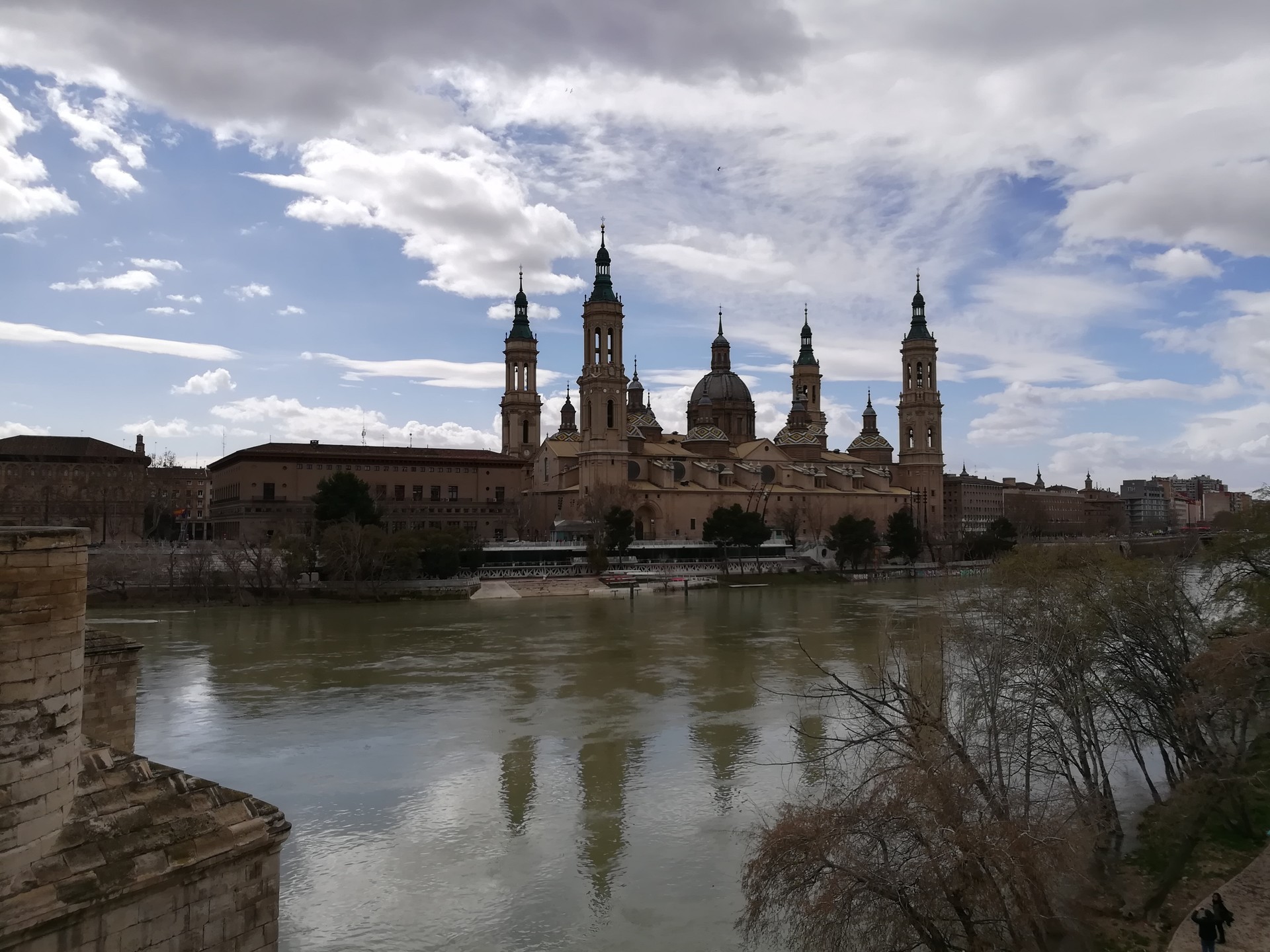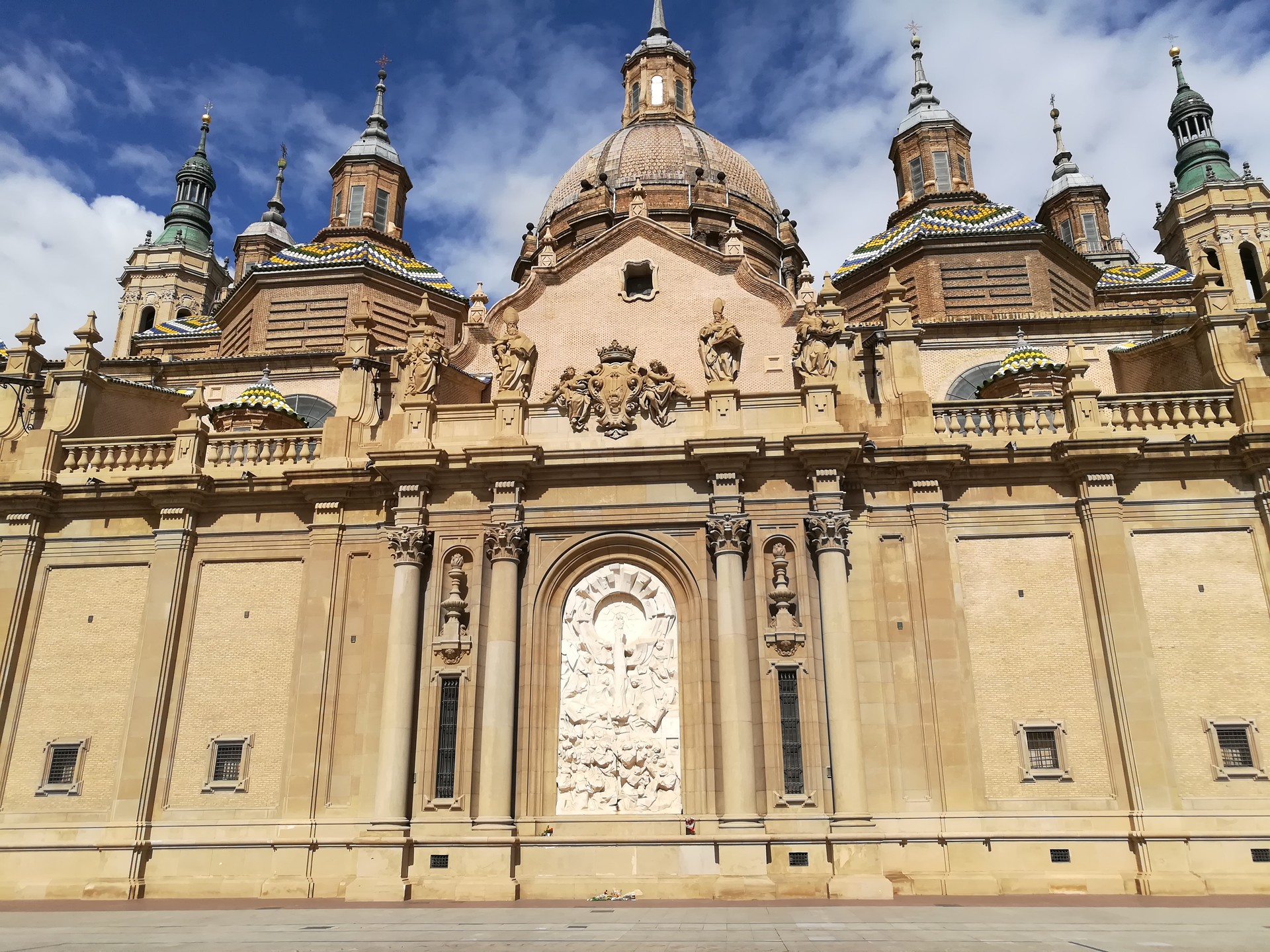The Cathedral-Basilica of Our Lady of the Pillar is a must-see attraction in Zaragoza: you simply cannot leave the city without having visited it. It's very likely that this cathedral will be the first thing that you see upon arrival in Zaragoza, as it's huge, imposing and is one of the first visible monuments; it will not go unnoticed simply thanks to its sheer size.
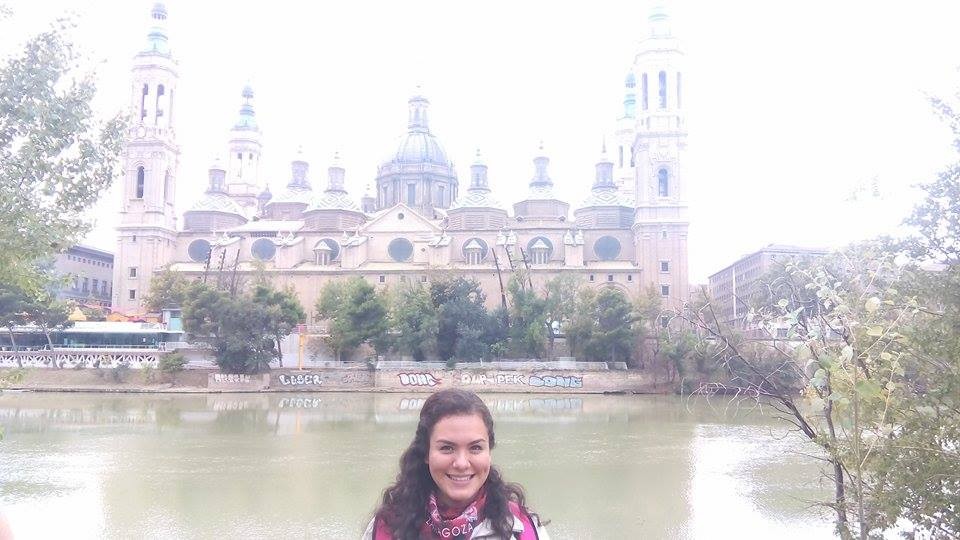
Photos are never sufficient on their own... What is the church like?
The church has a style that falls somewhere in between Baroque and Neoclassical: the architects, Felipe Busiñac and Felipe Sánchez, were in charge of its original construction, but it was Ventura Rodríguez who undertook the chapel's extension some years later. The latter architect is responsible for many important constructions in Spain: in fact, he designed the Plaza de Cibeles in Madrid, as well as the Noáin Aqueduct in Navarre and the Royal Chapel at the Royal Palace of Madrid, to name just a few of his most socio-historically relevant works.
The external materials used are nothing more than stone and brick, which makes it even more impressive that these structures could be built. Each of these four towers reach almost 100 metres in height, which you can travel up to the top of and enjoy the views with ease thanks to an access lift. The outer part of the domes are decorated with blue and yellow tiles.
The chapel is situated just next to the Ebro River, so the view that you get of it from the opposite side of the river, when crossing the Puente de Santiago or even the stone bridge, is just beautiful. It's preferable to look at it from the Puente de Santiago, simply on the basis that it's more modern and that you can see the chapel better from there, and you will be able to see the stone bridge in the background, which is much older and more "ad hoc" in terms of the surrounding landscape. At night, the chapel is lit up from almost all angles, making the towers seem even bigger and the architecture stand out even more. I think that it's important to observe it from every angle and be able to admire it in all its splendour, so that you fall in love with this architectural beauty.

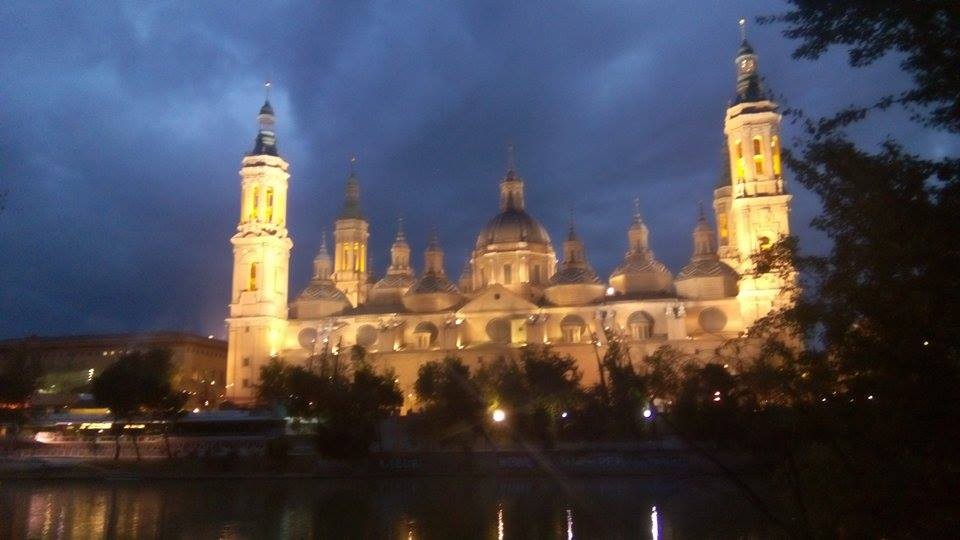
An interior that you will fall in love with...
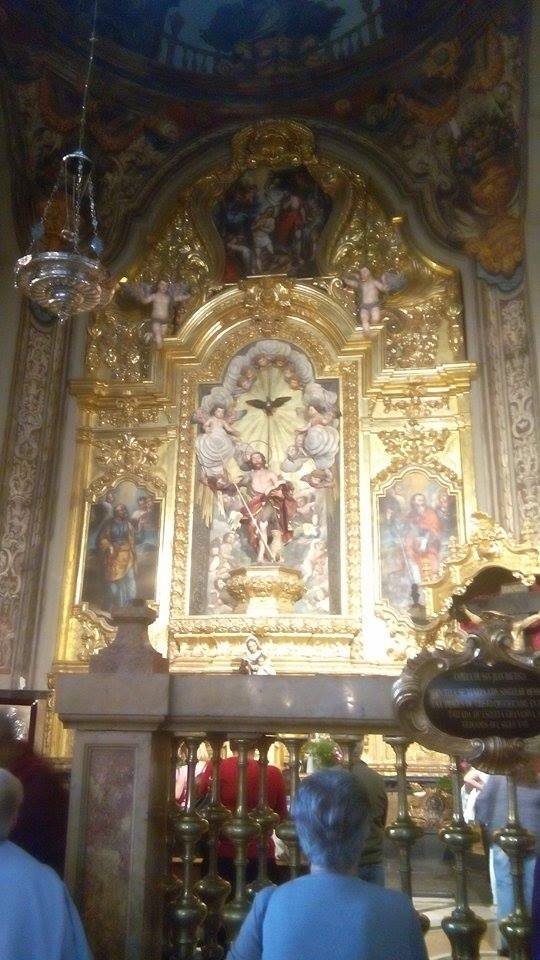
Once inside the cathedral, you will be left really impressed by the height and decoration of the central naves, while the thickness and the sheer size of the pillars will leave you speechless.
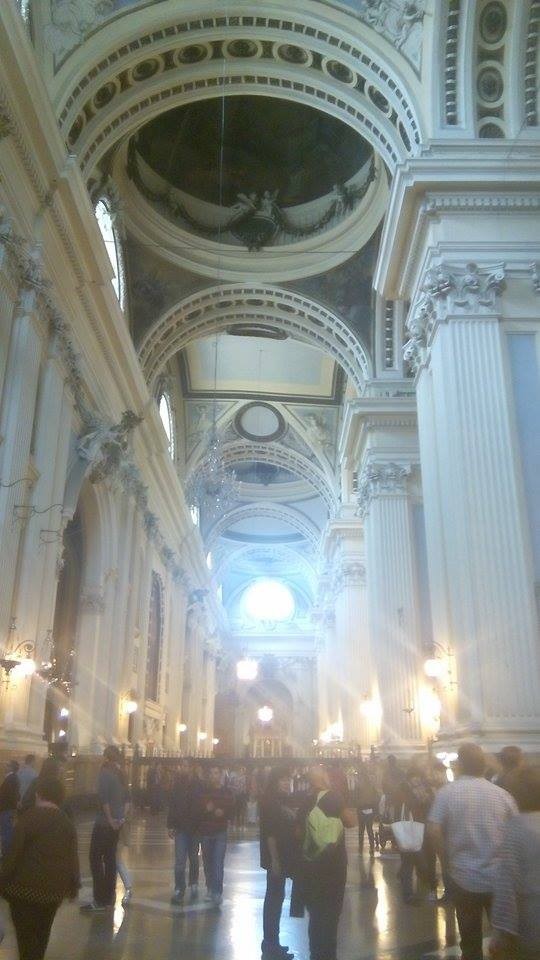
There are eleven domes, which, despite their immense size, are all painted with religious images representing the lives of the apostles and the saints.
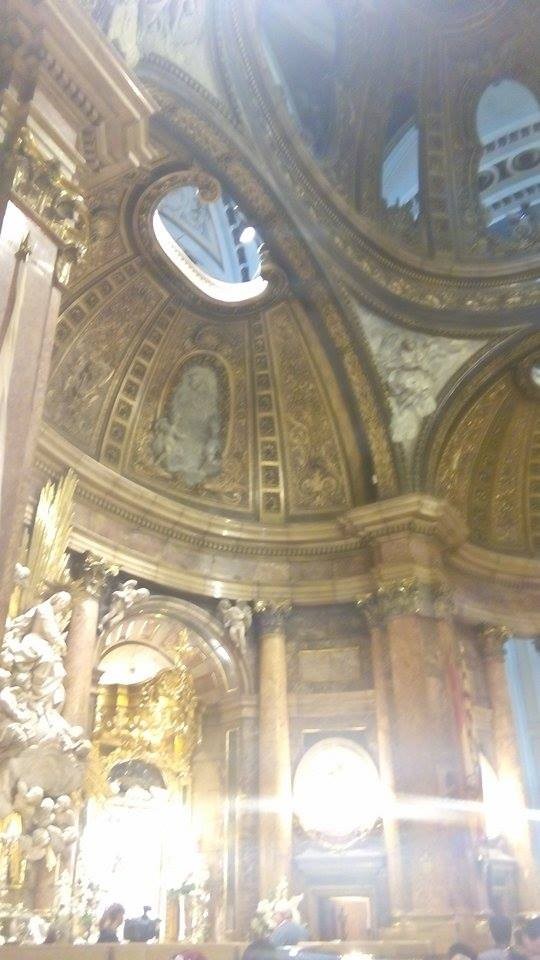
A little bit of history (the most important thing)
I am sure that you will ask what the reason was behind building such a big cathedral... well, a Christian legend states that, in this very spot, the Virgin Mary went to the apostle, James the Greater (the patron saint of Spain) and asked him to build her a chapel; he left her a column made of jasper ("El Pilar"), which ultimately left a token of his coming. In theory, they originally started by building a very small chapel made out of mud brick, which is where the cathedral stands today. With the passing of time, the original chapel has been extended, ultimately creating the majestic cathedral that Zaragoza is home to today. Inside the cathedral, there is a golden-coloured statue of "Our Lady of the Pillar", carved out of wood, with a height of 38 centimetres, which rests on top of the jasper column. This passing of time has also seen the construction of close to 11 chapels dedicated to different saints.
The Our Lady of the Pillar is a very important figure in Spain because she symbolises the Hispanic world: several bodies of deceased archbishops have been laid to rest inside this cathedral. This enormous construction is considered to be sacred and miraculous, as Zaragoza was one of the cities that was attacked during the Civil War by the Republican army. The story goes that, during the attack, four bombs were dropped on the cathedral and not a single of them exploded, although they did destroy a very small part of the structure by the strong impact of the height from which they were dropped. This fact was so important that, nowadays, two projectiles are kept and exhibited in the Santa Capilla to remember how truly miraculous the event was.
If you want to enter the cathedral, you can do so for free. However, if you want to take a tour around the other domes, see the unexploded bombs, or climb up to the top of the cathedral to admire the view of the Ebro River, you will need to join the queue (there are lots of people there during the Fiestas del Pilar) and make a small monetary contribution to visit the on-site Museo Pilarista.
The Fiestas del Pilar
Better known as Zaragoza's feast day celebrations, the Fiestas del Pilar are one of the most important annual events in the city and are what characterise it the most. Generally, the festivities begin the weekend of or before October 12th (for being the national day of Spain) and last around ten days. This week is so important that not even the students in Zaragoza have to attend classes while the festival takes place.
All of the events that take place during the festival are organised by the City Council, and involve organisations, groups, singers, and all the privately-owned stores in the city. Given the number of tourists that come here to enjoy the event, the financial reward is enormous.
I feel very fortunate for having been able to attend with my ESN (Erasmus Student Network) section, who organise trips at very reasonable prices for Erasmus students. My experience was incredible and this will form a small part of what I am going to tell you about in this review: a Mexican girl at the Fiestas del Pilar.
To get us into the festive mood: a pretty headscarf
Before arriving in Zaragoza, my ESN section gifted each us of members one of the famous Aragonese "cachirulos": this is a red and black headscarf or neckerchief and is a classic item of traditional male dress in the Aragon region. If you end up going to Zaragoza during the the Fiestas del Pilar, it will be normal for you to see lots of people wearing their cachirulo around their neck: be that men, women, or even pets dressed up for the occasion!

If you don't end up taking a cachirulo with you, don't worry at all! In the streets of Zaragoza, you will be able to find them on sale here, there, and everywhere. You will even be able to find them in any convenience store or gift shop.
The Virgin of Pilar and her floral offering
During my trip to Zaragoza, we were given a guided tour of the main points of interest in the city by a guy who lived in the city, who explained the most important things to us. One of the things that seemed really nice to me was that the statue of Our Lady of the Pillar was made out of golden-coloured wood and rests above the jasper column. Its decoration is simply beautiful because it is protected with bronze and silver lining in a Gothic style.
This sculpture dates back to 1435: it's over half a century old! Our Lady of the Pillar is located inside the cathedral, but during the festival, her statue is usually brought out to sit in the Plaza del Pilar (situated in front of the cathedral).

(In the background, you can just see the statue of Our Lady of the Pillar and the metallic four-storey structure where the flowers will go on October 12th. )
Firework display
At around 9pm, we found ourselves eating dinner in a park located on the other side of the Ebro River, where we saw the famous fireworks that lasted for around five minutes. It's incredible to see this at night and how the light is reflected in the river.
Food
During the Fiestas del Pilar, all the restaurants and food stands stay open until late, which, from what I have seen, is rare in Spain because they are usually closed even before 9pm. You will not only enjoy the restaurants located in the Plaza del Pilar, but also the temporary food stands that are grouped together along the other side of the river after crossing the Puente de Santiago. Here, you will be able to buy typical Aragonese food made fresh and sold exclusively during this festival period, so you cannot miss out on trying it!
Concert in the Plaza del Pilar
This was one of the best things about the night, as the team from Máxima FM hosted their concert, Máxima Independence, at the Fuente de Goya. This consisted of a three-hour long techno and electronic music concert with the radio station's best DJs playing. The atmosphere was incredible, as there were lots of people dancing and singing (when they could). There were more than 5000 people in the Plaza del Pilar enjoying this amazing concert with the impressive cathedral to one side of the stage.
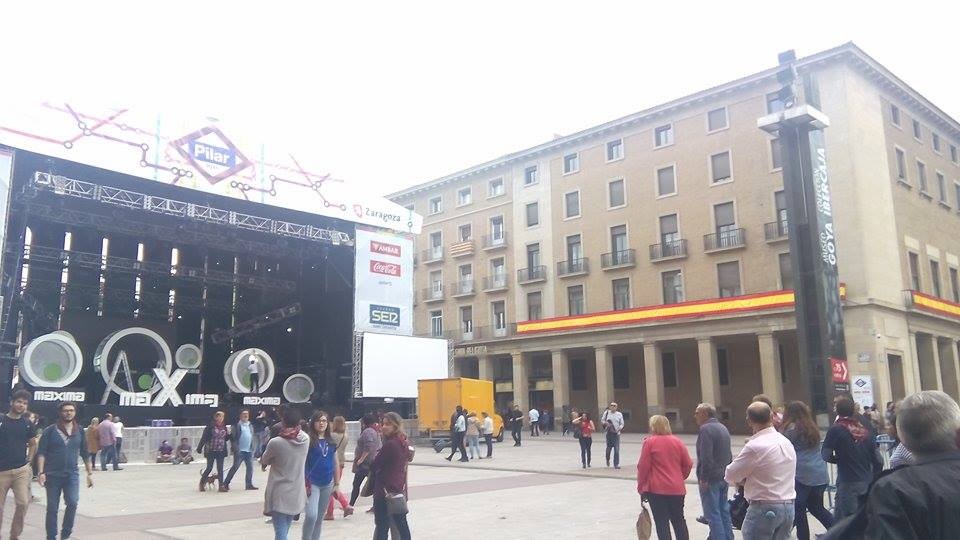
Bars in the Old Town
After the concert, we went to several bars that were open in the surrounding area. It's difficult to believe that we found so many bars open that were completely full of people, in spite of the fact that it was 4am. The streets were equally full of people, vendors, and nightclubs with lots of people dancing. It simply seemed like it was daytime.
Recommendations and things to take into consideration
Security before all else
The atmosphere in the Fiestas del Pilar is both varied and friendly. Even though lots of the celebrations take place at night and the consumption of alcoholic beverages in public spaces is permitted, the people are calm and, above all, show lots of respect for one another. It's really nice to see people of all ages coming together for the festival; I even saw babies being carried in their parents' arms and being pushed around in their prams in the middle of the Máxima FM concert. The main thing to take on board was that there was always security involved in the event: police officers stayed in the streets ready to respond to any potential situation that required their attention or assistance.
Do you need to use the toilet? A big issue to consider!
One of the biggest problems during the day was finding a toilet, as everything was either completely closed or, in the few businesses that were actually open, they only allowed you to use it if you purchased something. At night, the situation is a little bit different, as restaurants start to open and, with it being a special occasion, they allow you to use the bathroom without necessarily having to order anything to eat or drink. It took me around 50 minutes to be able to find a toilet every time I needed to use one. The other problem was that there was always a really long queue for the female toilet, especially in the restaurants in the Plaza del Pilar, so if you want to go to the toilet, one recommendation I would give to you is to consider the time you would lose by queuing and going to some streets located slightly further out from the square. There are smaller queues in bars or nightclubs because people more commonly go to the restaurants to use the bathroom.
Did you want to visit some museums?
The day that we did the tour around Zaragoza, I was excited about going to the Goya Museum for the Ibercaja Collection, but it came to my absolute surprise to find that all the museums (absolutely all of them) were closed. I couldn't go and see any attraction of this time, so if you want to come to the city for a purely cultural and academic visit, I don't recommend coming during this period.
And if I get lost?
Don't worry about it! Close to the Plaza del Pilar, there are two tourist information centres and three in the area in general. Ask them for a map of the city (they are free) and they will show you the most important museums, hotels and tourist attractions.
Will I get tired?
During these days of celebration, there are few places where you can sit down in the streets, as people are either walking around all the time or are watching concerts or other events. My recommendation would be to bring and wear the most comfortable trainers that you have.
How much does it cost to visit?
Food
You will be able to find meals for prices of just over 7€, drinks cost between 2. 50€ and 3€, and desserts, 3€. If you are tight for cash, I recommend going to a convenience store as everything is cheaper there.
Entrance to the basilica, the "Museo Pilarista"
Entry costs between 3€ and 4€.
Attractions and shows
They are completely free!
I want a cachirulo
The cachirulos will be cheaper if you buy them from the mobile street vendors, but you have to know how to play them because if they see that you are a tourist, they will bump their prices up for you. A cachirulo basically costs however much you can barter it down to: they first wanted to sell me one for 4€, but I wouldn't settle until they dropped the price down to 2€.
If you aren't in a rush to buy one, the most recommendable thing would be to buy one in the early hours of the morning because the vendors drop their prices and they end up charging you just 1€.
How do you get there?
The Plaza del Pilar is located to one side of its namesake cathedral. For directions, simply ask for the Puente de Santiago or the Puente de Piedra. You can also walk along the famous Avenida de Cesar Augusto, which almost runs into the river, and you will find the cathedral on your right. However, given how big it truly is, you will be able to find it from any point in the city.
What's the best time to visit the cathedral at?
During the Fiestas del Pilar, the cathedral is open from 6:45am to 8pm. I recommend going to the cathedral as early as possible, as the queues to enter are quite long during the festival week, and that was the reason why I couldn't visit the museum.
What can you tell me about the climate?
In October, it's quite cold in Zaragoza, especially in the evening. Although the sun is really strong during the day, you shouldn't trust the weather, and you should wear something that will keep you warm.
